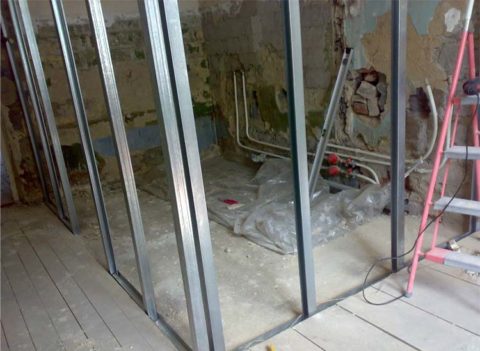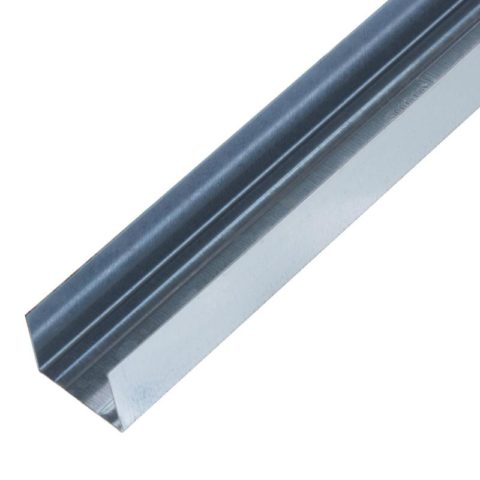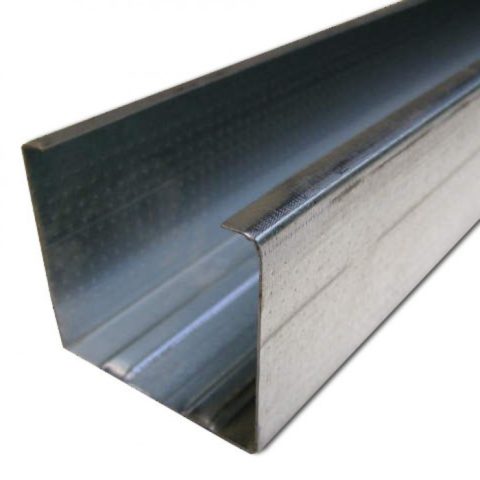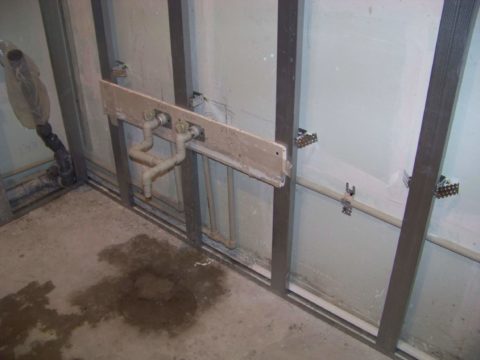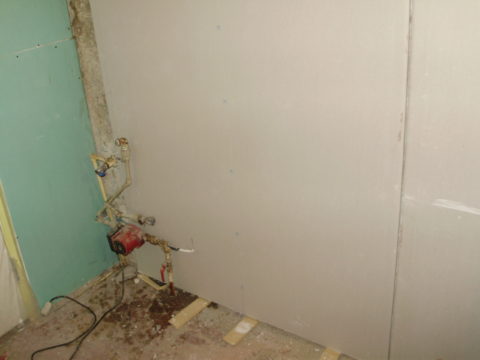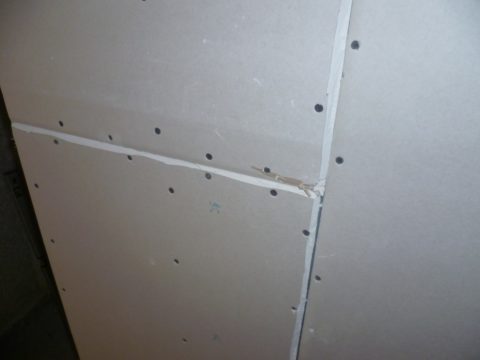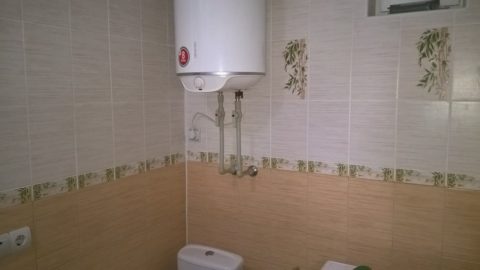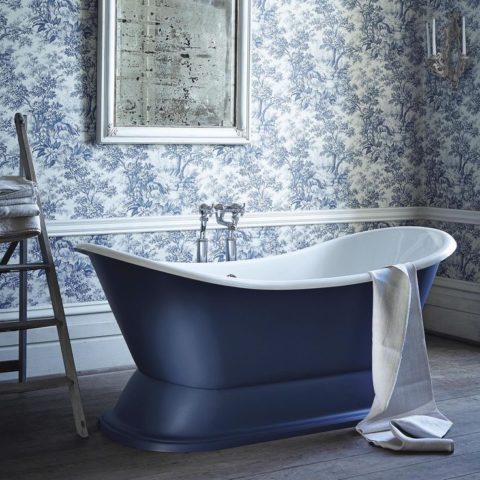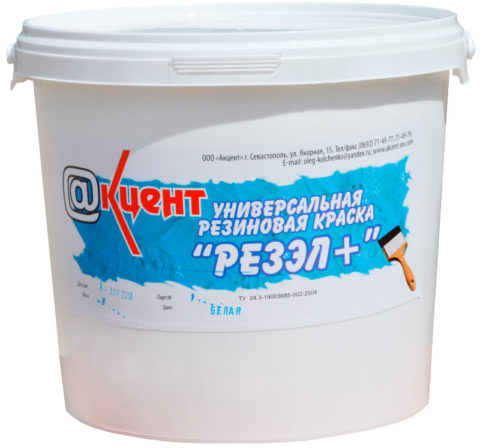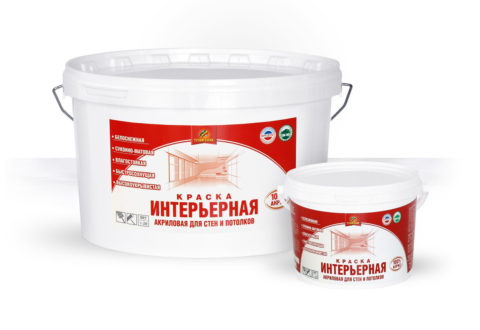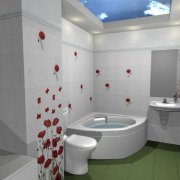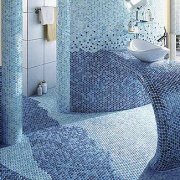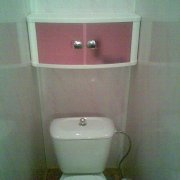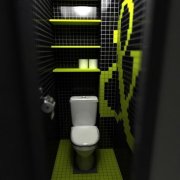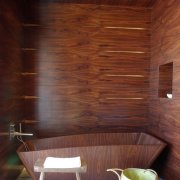How long does a drywall wall stand in the bathroom: features of the use of material in wet rooms
How reliable and durable is a drywall wall in a bathroom? Today we have to explore the complex relationship of this material with moisture and find out whether it can be used for finishing damp rooms. Let's get started.
The content of the article
Material properties
In the beginning - a few well-known, in general, facts.
- Gypsum is not a waterproof material. In particular, gypsum plasters and putties are never used for the exterior decoration of buildings. With prolonged contact with moisture, the hygroscopic mineral swells and softens;
- On sale, however, you can find moisture-proof drywall (GKLV). It is easy to recognize by the bluish-green color of the front surface. GKLV is intended by the manufacturer specifically for the decoration of wet rooms;
Useful: the moisture resistance of the material consists in the use of dense and water-resistant kraft paper as a shell, as well as the presence of antifungal additives in the composition of the gypsum core.
- With prolonged contact with water, moisture-proof drywall becomes unusable in the same way as ordinary. The swollen core becomes soft and crumbles under the most minor mechanical influences.
findings
Actually, they come down to one postulate: the wall of drywall in the bathroom should not directly contact with water. It must be protected by a moisture resistant finish.
In addition: drywall walls in the bathroom will be more durable if the room is effectively ventilated. Constant dampness will help the fungus to hit any finish. Even if it contains antiseptic additives: they are washed perfectly with water.
Personal experience
In the house of the author of these lines there are two combined bathrooms, and in both bathrooms the walls are made of gypsum plaster:
Not only that: during the construction of the mansard bathroom, an ordinary (white) wall drywall was involved. Moisture-proof is very inappropriately over, and the usual GCR was in excess.
- After five years of living in a new house and four years that have passed since the construction of the attic, some results can be summed up.
- There are no signs of the destruction of the walls, or at least the loss of mechanical strength by them.
- Even near the cat’s toilet, where the claws of a family’s favorite pet periodically pass over the painted surface, the walls of the drywall bathtub have retained their original appearance.
- The only drawback of the material is that it is more difficult to hang a cabinet, a water heater or a shelf on the GCR.
- The problem, however, is solvable: it’s enough to glue a small sheet of 15 mm plywood to the back of its sheathing.
However: for a boiler with a volume of 50 or more liters, it is desirable to assemble a full-fledged wooden frame from a thick beam inside the wall. It must carry the load from the casing and lightweight frame of the wall to the floor.
Installation Rules
Now let's move on to how to make drywall walls for bathtubs as durable as possible (see Drywall bathroom).
The video in this article will more clearly introduce you to how to decorate the walls of bathrooms with drywall.
Frame
The frame of future walls is usually made of a bar with a thickness of 50 mm or a galvanized profile.The main argument in favor of the bar is its slightly lower price, which saves 5-10% of the construction budget.
In articles on related topics, the author has repeatedly recommended using only and exclusively a profile as frame elements.
In the case of a bathroom with its high humidity, this instruction is especially relevant for two reasons:
- Wood warps when moisture fluctuates. The deformation of the frame will inevitably affect the appearance of the wall in the bathroom from drywall;
- Wood is a tasty food for the fungus. Mold and rot can reduce the life of the wood frame to 5-8 years.
To assemble the frame of the partition surrounding the bathroom, two types of profile are used:
| Picture | Type of profile |
| Guide: it provides fastening of the frame to adjacent structures (ceiling, floor, solid walls). | |
| Rack: drywall is attached to it with self-tapping screws. |
A few recommendations for installing the frame:
- If space is limited, use the thinnest profile with a width of 50 mm. Its low stiffness is easily compensated by connecting the racks in pairs;
- Lay a foam damping tape under the guides. It will noticeably lower the volume of sounds coming from the bathroom;
- Fill the frame after sheathing one of its sides with mineral wool. The goal is the same - maximum insulation of the room.
If you plaster the main walls of the bathroom with plasterboard, then the ceiling profile (PP, aka CD) is used as a lathing. It is attached to the base with direct suspensions; along the perimeter of each wall mounted guide ceiling profiles UD (PNP).
Plan “B”: in case of acute shortage of space, drywall in the bathroom can be mounted on the walls without crate, on mounting plaster glue. It can be successfully replaced by any gypsum plaster or putty.
Reinforcement
Using the bath for its intended purpose involves constant fluctuations in humidity. And if so, the linear dimensions of the drywall sheets will continuously change (albeit in a narrow range of values), which will quickly lead to the appearance of cracks in the assembly joints.
The solutions to this problem are, in general, relevant for any drywall constructions; in the bathroom, the right technique for reinforcing seams only becomes particularly important.
So:
- The edges of any pair of adjacent sheets should be attached to their common profile;
- The edges of the sheets cut in place before filling should be embroidered (the so-called chamfering). Stitching contributes to the deep filling of the seam with putty;
- Seams are necessarily reinforced. Usually, a self-adhesive fiberglass mesh (serpyanka) is used for reinforcement, but the author likes thinner fiberglass more. It is glued along the seam to PVA glue diluted with water, after drying the first layer of the putty filling the seam.
Fine finish
What and how to finish drywall in a wet room with your own hands?
The key requirement we have already mentioned is the waterproofness of the finish. Let's move on to specific examples.
| Picture | Description |
| Tile. Tiles can be laid over the entire surface of the walls (seeFacing with gypsum plasterboard: do it right), or used for mounting aprons over the bathtub and washbasin. It can be glued to drywall with ordinary cement glue or, as the author did, to spotted silicone. For joints waterproof grouts are used - epoxy and silicone. | |
| Thick vinyl wallpaper. It is dense - they, unlike foamed vinyl, create a full-fledged barrier to dampness and are easily washed from the inevitable pollution in the bathroom.Gluing them in the bathroom should not be on wallpaper glue, but on waterproof PVA. | |
| Water-based rubber waterproofing paint. Do not be alarmed by the name: the texture of the painted surface is a regular mat or half gloss. That is how the bathroom is decorated in the attic of the author; the paint is perfectly washable, resistant to dry abrasion and lasts at least a decade. |
Now - a few words about what you should not do when decorating a bathroom.
- Glue wallpaper over the bathtub or washbasin. Limescale and splashes of detergents will quickly turn the once elegant wallpaper into something that looks very much like a floor rag;
- Collect aprons over the bathtub and sink from plastic wall panels. Their seams are leaky, so water will inevitably fall under them. Dampness will quickly lead to damage to the walls of the fungus;
- Use for painting walls near the bathtub and washbasin conventional interior water emulsions. The coating will quickly spread out and the walls will become untidy.
Conclusion
We hope that our recommendations will help the reader in the repair of their own housing. The video in this article will more clearly introduce you to how to decorate the walls of bathrooms with drywall. Good luck!




